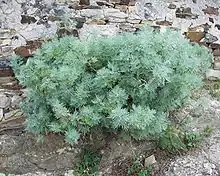Artemisia arborescens
Artemisia arborescens, the tree wormwood, is a species of flowering plant in the family Asteraceae, native to the Mediterranean region.[2] It is an erect evergreen perennial, with masses of finely-divided aromatic silvery-white leaves and single-sided sprays of yellow daisy-like flowers. This plant is cultivated for its foliage effects, but in colder temperate regions it requires the protection of a wall.
| Artemisia arborescens | |
|---|---|
 | |
| Scientific classification | |
| Kingdom: | Plantae |
| Clade: | Tracheophytes |
| Clade: | Angiosperms |
| Clade: | Eudicots |
| Clade: | Asterids |
| Order: | Asterales |
| Family: | Asteraceae |
| Genus: | Artemisia |
| Species: | A. arborescens |
| Binomial name | |
| Artemisia arborescens | |
| Synonyms[1] | |
| |
The specific epithet arborescens means "woody" or "tree-like".[3]
This plant[4] and the cultivar 'Powis Castle'[5] have gained the Royal Horticultural Society's Award of Garden Merit.[6]
'Powis Castle' is relatively compact, and unlike typical A. arborescens, it rarely flowers. It has a strong sweet smell, quite different from that of A. arborescens. It has been suggested to be a hybrid between A. arborescens and A. absinthium, but is probably a form from the Middle East where arborescems and absinthium appear to intergrade. The original source is unknown, but British gardener Jim Hancock took a cutting of a plant that he found growing during a garden visit in Yorkshire c1968, and took it to Powis Castle when he became Head Gardener there in 1972. It was later named from that garden, propagated and sold to promote the National Trust gardens.[7]
This plant, like others of the genus Artemisia, yields essential oils which have historically been used for various medicinal purposes, and its pharmacological properties are under investigation.[8][9] It also has culinary uses, including as a substitute for or supplement to spearmint in Maghrebi mint tea during the winter (when mint is out of season), imparting a bitter flavor.[10]
Gallery
References
- The Plant List Artemisia arborescens L.
- Altervista Flora Italiana, Assenzio arbustivo Artemisia arborescens (Vaill.) L.
- Harrison, Lorraine (2012). RHS Latin for gardeners. United Kingdom: Mitchell Beazley. p. 224. ISBN 9781845337315.
- "RHS Plant Selector - Artemisia arborescens". Retrieved 23 February 2020.
- "RHS Plant Selector - Artemisia arborescens 'Powis Castle'". Retrieved 14 April 2020.
- RHS A-Z encyclopedia of garden plants. United Kingdom: Dorling Kindersley. 2008. p. 1136. ISBN 978-1405332965.
- JD Twibell, Plant Identification from Vapour Analysis, The Plantsman 14 (3) 184-190 1992
- Saddi, Manuela; Sanna, Adriana; Cottiglia, Filippo; Chisu, Lorenza; Casu, Laura; Bonsignore, Leonardo; De Logu, Alessandro (2007). "Antiherpevirus activity of Artemisia arborescens essential oil and inhibition of lateral diffusion in Vero cells". Annals of Clinical Microbiology and Antimicrobials. 6: 10. doi:10.1186/1476-0711-6-10. PMC 2099429. PMID 17894898.
- "GlobinMed – A unique interactive e-database with validated, up-to-date and comprehensive information on Integrated Medicine".
- Artemisia: An Essential Guide from The Herb Society of America (PDF), The Herb Society of America, 2013, archived from the original (PDF) on 2015-09-05

